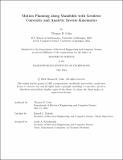Motion Planning along Manifolds with Geodesic Convexity and Analytic Inverse Kinematics
Author(s)
Cohn, Thomas B.
DownloadThesis PDF (14.47Mb)
Advisor
Tedrake, Russell L.
Terms of use
Metadata
Show full item recordAbstract
Collision-free motion planning is a fundamental problem in robotics. Most motion planning algorithms operate in the configuration space of a robot, where each dimension corresponds to an individual degree of freedom. Oftentimes, these configuration spaces can be viewed as Euclidean spaces, and many motion planning algorithms treat them as such. However, many configuration spaces of interest are inherently non-Euclidean, including those of mobile robots, robot arms that have revolute joints without limits or ball joints, and flying robots, as well as the constrained configuration spaces that arise when planning with task-space constraints. In this thesis, we treat the problem of motion planning along Riemannian manifolds, a broader class of spaces that encompasses many of the problems of interest.
In the first chapter, we present a generalization of the graph of convex sets (GCS) planning framework that can handle smooth manifolds. GCS uses convex optimization, and is thus restricted to Euclidean configuration spaces. Our analysis utilizes geodesic convexity to achieve the same guarantees on Riemannian manifolds, and we leverage this to produce motion plans for mobile robots whose arms have unbounded revolute joints.
In the second chapter, we specifically consider the problem of constrained bimanual manipulation, where a robot has to move an object that is being grasped with two hands. The set of kinematically-valid configurations is a union of submanifolds, implicitly defined by nonlinear equality constraints This presents significant challenges for standard unconstrained planning algorithms. We construct a smooth parametrization of the feasible set, recasting the problem without equality constraints. Our approach is algorithm-agnostic, and we demonstrate that unconstrained planners (working through the parametrization) produce favorable results.
Date issued
2024-05Department
Massachusetts Institute of Technology. Department of Electrical Engineering and Computer SciencePublisher
Massachusetts Institute of Technology